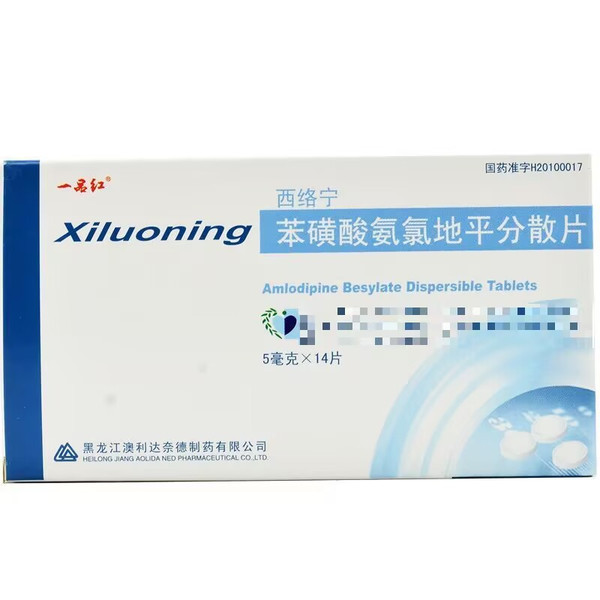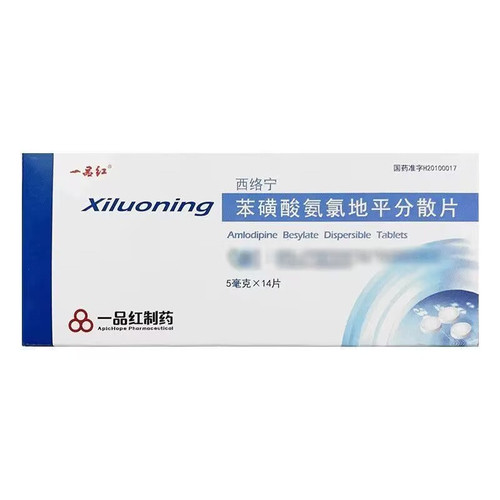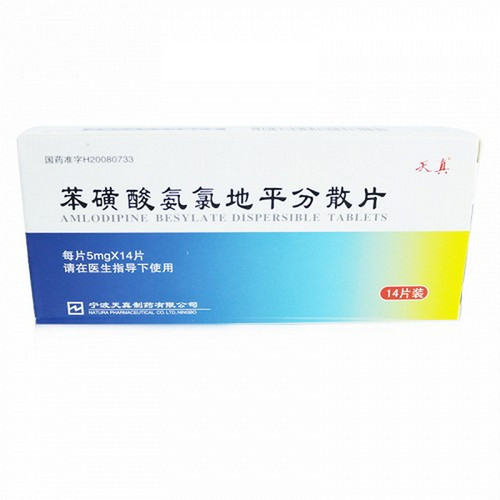Product Overview
[Drug Name]
Generic Name: Amlodipine Besylate Dispersible Tablets
Trade Name: Xiluo Ning
English Name: Amlodipine Besylate Dispersible Tablets
Chinese Pinyin: BenHuangSuanAnLvDiPingFenSanPian(XiLuoNing)
[Main Ingredient]
Amlodipine Besylate.
[Properties]
This product is white or off-white tablets.
[Indications]
1. Hypertension. This product can be used alone or in combination with other antihypertensive drugs. 2. Chronic stable angina and variant angina. This product can be used alone or in combination with other antianginal drugs.
[Dosage and Administration]
1. For the treatment of hypertension, the initial dose is 5 mg once daily, with a maximum dose of 10 mg once daily. For frail or elderly patients, or those with hepatic insufficiency, the initial dose is 2.5 mg once daily. This dose may also be added to other antihypertensive drugs. Dose adjustments should be made based on individual patient response. Generally, dose adjustments should be initiated after 7-14 days. If clinically indicated, dose adjustments may be initiated sooner, provided the patient is under close observation. 2. The initial dose for the treatment of angina pectoris is 5-10 mg once daily. Lower doses are recommended for elderly patients and those with hepatic impairment. The effective dose for most patients is 10 mg/day.
[Adverse Reactions]
Amlodipine is well tolerated. In placebo-controlled clinical trials for the treatment of hypertension or angina pectoris, the most common adverse events were: autonomic nervous system: flushing; general: fatigue; cardiovascular, general: edema; central and peripheral nervous system: dizziness and headache; gastrointestinal: abdominal pain and nausea; heart rate/rhythm: palpitations; psychological: somnolence. No significant clinical laboratory abnormalities related to this drug were observed in these clinical trials. Less common adverse events observed after marketing include: Autonomic nervous system: dry mouth, increased sweating; Systemic: weakness, back pain, malaise, pain, weight gain/loss; Cardiovascular, general: hypotension, syncope; Central and peripheral nervous system: high muscle tone, hypoesthesia/paresthesia, peripheral neuropathy, tremor; Endocrine: breast hyperplasia; Gastrointestinal: changes in bowel habits, dyspepsia (including gastritis), gingival hyperplasia, pancreatitis, vomiting; Metabolic/nutritional: hyperglycemia; Musculoskeletal Bone: Arthralgia, muscle cramps, myalgia; Platelet/Hemorrhage/Coagulation: Purpura, thrombocytopenic purpura; Psychological: Impotence, insomnia, change in attitude; Respiratory: Cough, dyspnea; Skin/Appendages: Alopecia, skin discoloration; Special Senses: Taste disturbances, tinnitus; Urinary: Frequent urination; Vascular (Extracardiac): Vasculitis; Visual: Visual impairment; Leukocyte/Reticuloendothelial System: Leukopenia; Allergic reactions are rare and include pruritus, rash, angioedema, and erythema multiforme. Very rare cases of hepatitis, jaundice, and elevated transaminases (usually consistent with cholestasis) have been reported. Severe cases requiring hospitalization have been reported in association with amlodipine use, but in most cases, a causal relationship has not been established. Similar to other calcium channel blockers, the following adverse events have been reported rarely, but these events are difficult to distinguish from the natural history of the underlying disease: myocardial infarction, arrhythmias (including bradycardia, ventricular tachycardia, and atrial fibrillation), and chest pain.
[Contraindications]
This product is contraindicated in patients with hypersensitivity to dihydropyridines or any of the ingredients in this product.
[Precautions]
1. Warning: A very small number of patients, especially those with severe coronary artery obstructive disease, may experience increased frequency, prolonged duration, or severity of angina pectoris, or acute myocardial infarction, when initiating or increasing the dose of calcium channel blockers. The mechanism of action is currently unknown. 2. Because the vasodilatory effect of this product occurs gradually, rare cases of acute hypotension have been reported after taking this product. However, caution should be exercised in patients with severe aortic stenosis when using this product in combination with other peripheral vasodilators. 3. Use in Patients with Heart Failure: Calcium channel blockers should be used with caution in patients with congestive heart failure. In a long-term, placebo-controlled study (PRAISE-2) conducted in patients with non-ischemic heart failure (NYHA class IV), although the incidence of exacerbations of heart failure was not significantly different from placebo, there was an increase in reports of amlodipine-related pulmonary edema. 4. Use in Patients with Impaired Hepatic Function: As with all calcium channel blockers, the half-life of this drug is prolonged in patients with impaired hepatic function. However, a recommended dose has not yet been established. Therefore, this drug should be used with caution. 5. Use in Patients with Renal Failure: Changes in amlodipine plasma concentrations are not correlated with the degree of renal impairment. Therefore, a normal dose can be used. This drug is not eliminated by dialysis. Please read the package insert carefully and use as directed by your doctor.
[Use in Special Populations]
Precautions for Pediatric Use:
There are no data available for the use of this drug in children.
Precautions for Pregnancy and Lactation:
There are no studies on its use in pregnant women. However, animal studies have shown that a 10 mg/kg dose of this drug can cause reduced litter size, increased stillbirths, delayed delivery, and premature labor in rats. Therefore, this drug should be used in pregnant women only when absolutely necessary. It is unknown whether this drug is excreted in breast milk. Breastfeeding women taking this drug should discontinue breastfeeding.
[Precautions for Elderly Patients]
The time to peak plasma concentration of this drug is similar in elderly and younger patients. The increased area under the concentration-time curve (AUC) and prolonged elimination half-life in elderly patients lead to a decreased clearance rate. Reports indicate that elderly patients tolerate similar doses of amlodipine as well as younger patients. Therefore, elderly patients can use the normal dose. However, it is advisable to start with a lower dose and then gradually increase it.
Pharmacological Action
Amlodipine is a calcium channel blocker (also known as a slow-channel blocker or calcium antagonist) that blocks the transmembrane entry of calcium ions into myocardial and vascular smooth muscle cells. The mechanism of amlodipine's antihypertensive effect is direct relaxation of vascular smooth muscle. The exact mechanism of relieving angina pectoris is not fully confirmed, but it may relieve angina pectoris by dilating peripheral arterioles and coronary arteries, reducing total peripheral vascular resistance, relieving coronary artery spasm, lowering cardiac afterload, and reducing cardiac energy consumption and oxygen demand.
[Storage] Store in a dark, sealed container.
[Strength] 5 mg (as amlodipine)
[Packaging] 5 mg/tablet x 14 tablets/box
[Expiry Date] 36 months
[Approval Number] National Medicine Standard H20100017
[Manufacturer] Company Name: Heilongjiang Aolidanide Pharmaceutical Co., Ltd.






